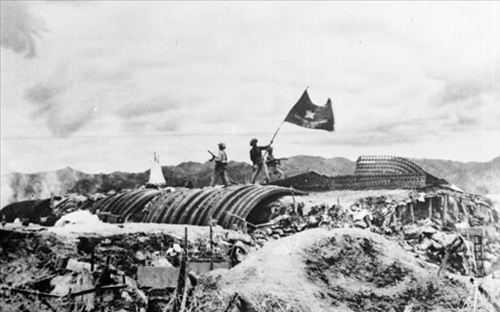The Dien Bien Phu victory on the afternoon of May 7, 1954 played a decisive role in ending the resistance war against French colonialists, showing the bravery of the Vietnamese people and military, and becoming one of the glorious milestones in the history of Vietnam's struggle for national independence.
    |
 |
|
The flag “Determined to fight, Determined to win" on the roof of the General De Castries’ bunker on the afternoon of May 7, 1954 |
This historic milestone led to the Geneva Accords in 1954 which aimed at restoring peace, ending the French troop presence in Indochina and officially putting an end to the French colonial rule on the peninsula. This milestone opened a new chapter for the Vietnamese, Lao, and Cambodian revolutions, and made a significant contribution to national liberation movements, marking the beginning of the collapse of old colonialism worldwide.
The victory was the result of many factors. Apart from the wise leadership of the Communist Party of Vietnam and President Ho Chi Minh, the willpower and strength of the Vietnamese people and army, their passionate patriotism is also an extremely important factor. The thousands of years of national building and defending have shown that patriotism is the foundation of the spirit of independence, self-reliance, strong will, resilience, brainpower and mettle of Vietnam. That factor contributed to a brave decision to change the combat strategy from "fast strive, fast victory" to "steady attack, steady advance" to cope with the strong defence of the enemy.
The "golden history" of Dien Bien Phu echoed throughout the continents, not only crushing the invading ambitions of the French colonialists and American intervention, but also lingering with time, across generations. Therefore, scholar and journalist Bernard B. Fall, a professor at Howard University in Washington, D.C., once wrote, "Whether we like it or not, that war will affect us for many decades to come."
In May 2023, Vietnam marked the 69th anniversary of the Dien Bien Phu Victory. Following national reunification in 1975, the country has overcome countless challenges, crises and difficult times. The center of Dien Bien, the mountainous area with its rugged hills and surrounded by forests full of bombs, has transformed into a bustling urban area. The dream of "Dien Bien taking flight" is gradually becoming a reality.
Sixty nine years after the historic Dien Bien Phu victory, Vietnam is nurturing and determinedly pursuing its aspirations and goals of ensuring the people's well-being, building a strong and prosperous nation. However, this is a very heavy, and complex task with countless challenges. The Resolution adopted by the 13th National Party Congress has clearly defined the vision and development direction of the country, "In the coming years, the world and domestic situations will present both favorable and difficult conditions that pose new requirements for the cause of national construction and defense. Such requires the whole Party, people, and military to unite as one; continue to strongly innovate thinking, have high political determination, accurately forecast and promptly respond to all situations.”
To achieve this goal, many factors are required. As Party General Secretary Nguyen Phu Trong said, "The path ahead is still full of difficulties, challenges, and interwoven opportunities and favorable conditions. Whether we can awaken our potential and turn it into a great resource to build and protect the country or not depend on the will, determination of the entire Party and every Vietnamese citizen."
So at this moment, the lesson of the historic Dien Bien Phu victory is still relevant. That lesson reminds that along with the wise leadership of the Party and State, the great unity of the entire Party, military and people, the strong patriotism is also an extremely important factor in realizing the aspirations of the era "Wealthy people, strong nation, equitable society with democracy and civilisation." That aspiration is as sacred and powerful as the national will for independence, peace and reunification in the 20th century.
Source: VNA